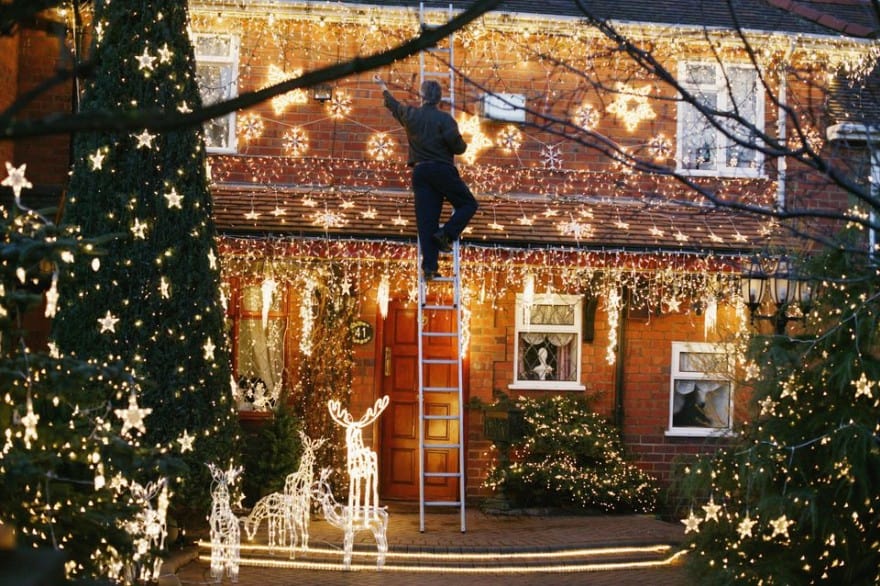During the holidays, outdoor home lighting can give your property a fun and festive look. While porch lights, path lights, and security lights serve a functional purpose, it can also be fun to add holiday-themed string lights or accent lights to your outdoor space. Strings of pumpkin-shaped lights around Halloween or candy-cane-shaped lights for Christmas can add an extra bit of dazzle to your home.

Of course, as with all other projects around your house, safety needs to be one of your top priorities. This is especially true when it comes to lighting.
Anytime electricity is involved, it is extremely important to take all of the necessary safety precautions. Adhering to proven safety guidelines for outdoor holiday lights is the best way to ensure that you and your family stay safe.
A lot of times, people mistakenly believe that holiday lights don’t have to meet the same safety requirements as standard lights, simply because they are only being installed on a temporary basis. As it turns out, however, safety is every bit as important with these types of lights as it is with any other lighting.
In fact, it may even be more important since the connections that these lights rely on often pose unique dangers that are not present with other types of lighting. There are guidelines in the National Electric Code for temporary installations that need to be followed closely.
Use Fixtures That Are Designed For The Outdoors

Source: http://bit.ly/2ysE7yI
When it comes to outdoor home lighting, the fixtures that you choose need to be specifically designed to withstand the elements. For instance, because porch lights are exposed to rain and other types of wet weather, they need to be rated for use in locations that are damp. Because temperatures and weather conditions can fluctuate so much outdoors, you should look for fixtures that are approved for outdoor use.
The same holds true for wall fixtures, outlets, power cords, and other electrical connections. All of these items should be rated as being weatherproof or weather resistant. In some cases, they may also be listed as being suitable for damp or wet locations.
Choose Light Bulbs That Are Designed For Outdoor Use

Source: http://bit.ly/2AGJ2SB
Even if your light fixtures are fully enclosed, you should still use light bulbs that are rated for use outdoors. These bulbs do a better job of standing up to the changing weather conditions that they experience outdoors.
If you can’t find light bulbs that are specifically designed for outdoor use, you can look for bulbs that are designed for appliances such as refrigerators or ovens since they also have to be able to withstand extreme temperatures.
Choose The Right Wattage

Source: http://bit.ly/2zbP0Z7
Check light fixtures for the maximum wattage that they are capable of handling. Usually, this is printed on a label that is attached directly to the fixture. Never install a light bulb that has a higher wattage than the number that is printed on this label. If you do, you could risk causing the wiring to overheat.
This could result in damage to the wire’s insulation, creating a real safety hazard. Remember, however – this number only applies to the bulb’s actual wattage. Many LED or compact fluorescent bulbs are sold as being equivalent to certain wattage is in an incandescent bulb. However, they use far fewer watts during operation. Look at the actual usage number when deciding whether or not a light bulb is appropriate for a particular fixture.
Choose Extension Cords That Are Designed For Outdoor Use

Source: http://bit.ly/2AG8LdD
Indoor extension cords are lightweight and flexible, making them convenient to use inside your home. Unfortunately, however, they are not designed to withstand the weather. Never use an indoor extension cord outdoors. Instead, look for an extension cord that is designed specifically for outdoor use.
You should be able to find a label on your extension cord that designates what type of use it is appropriate for. Some are rated only for use indoors. Others can be used indoors and outdoors or only outdoors, depending on their rating.
Avoid Putting Lights Near Items That Could Catch On Fire

Source: http://bit.ly/2kteZ5V
Certain kinds of light bulbs can get quite hot when they are in use. To minimize the risk of fire, avoid using light bulbs near any materials that are flammable.
For instance, if you set up a nativity scene in your yard, use caution when you are lighting it. Most nativity scenes have hay or straw included in them. These items can easily catch on fire. Avoid using light bulbs near them since the heat from the bulb could cause them to burst into flames.
Author Bio

Brandon loves the lighting – from studio to lawn lighting. He was an interior designer by profession but chose to practice a different job. At night, he loves watching the night sky as he believes this is the most wonderful light.
Related Posts
- How to Protect Sliding Glass Doors from Burglars: Essential Security Tips
- How Long Do Sliding Glass Doors Last? Durability and Lifespan Explained
- Here Are Some Pros and Cons of Textured Walls in Homes
- Why Do Sliding Doors Get Stuck? Common Causes and Solutions
- Comparison of Knockdown Drywall Texture vs Orange Peel
- Some FAQ (Frequently Asked Questions) About Wall Paneling for Homes
Leave a Reply